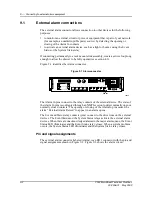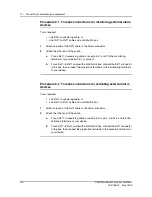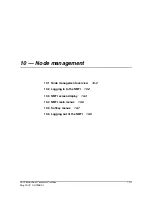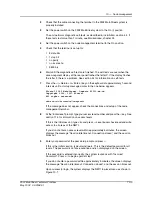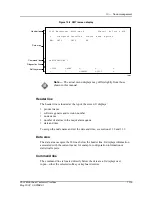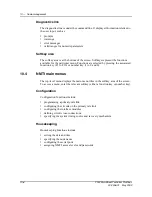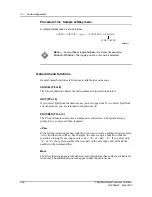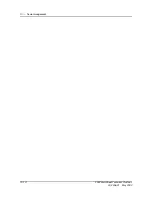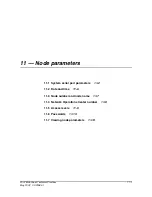
11 — Node parameters
11-2
2902 MainStreet Technical Practices
90-2906-01 May
2002
11.1
System serial port parameters
The two serial ports can be configured for device type, baud rate and flow control.
Serial port 1 (labeled Terminal) is configured as a DCE device. Serial port 2 (labeled
Modem) is configured as a DTE device. The data format for both ports is 8 data bits,
1 stop bit, no parity and no local echo.
Device type
Configure the serial port device type to match the type of node management
equipment connected to the port. If you change the device type of the serial port that
is communicating with the node management equipment, the display is updated, but
the change does not take effect until you log out of the node.
Three types of node management equipment can be connected to a serial port:
•
a VT100-compatible terminal (VT100)
•
a printer (PRINTER)
•
a computer (VT100, CPSS, CPSS_MODEM)
The default for serial port 1 is VT100. The default for serial port 2 is
CPSS_MODEM. Typically, serial port 2 connects to a modem that connects to
a 5620 NM or a PC running the Craft Interface Node Manager.
VT100-compatible terminal
A VT100-compatible ASCII terminal can be connected to a serial port either directly
or indirectly (remotely through a Hayes-compatible auto-answer modem). The
VT100 terminal is used for node management sessions. An EIA/TIA-232 compatible
device, such as a PC, must be connected to the other serial port for certain node
management activities (such as configuration database backup and restore).
Printer
A serial printer can be locally connected to a serial port so that alarms can be printed
out; see section 25.6 in
Maintenance
for more information about how to enable or
disable the printer.
Summary of Contents for MainStreet 2902
Page 1: ...2902 MainStreet Network Termination Unit Release 1 0 H T E C H N I C A L P R A C T I C E S ...
Page 40: ...3 Mounting the unit 3 8 2902 MainStreet Technical Practices 90 2906 01 May 2002 ...
Page 50: ...4 Ground and power connections 4 10 2902 MainStreet Technical Practices 90 2906 01 May 2002 ...
Page 68: ...6 Connecting to the network 6 4 2902 MainStreet Technical Practices 90 2906 01 May 2002 ...
Page 90: ...7 Connecting to data devices 7 22 2902 MainStreet Technical Practices 90 2906 01 May 2002 ...
Page 108: ...10 Node management 10 10 2902 MainStreet Technical Practices 90 2906 01 May 2002 ...
Page 150: ...14 CPSS 14 6 2902 MainStreet Technical Practices 90 2906 01 May 2002 ...
Page 218: ...20 Codirectional DCM 20 6 2902 MainStreet Technical Practices 90 2906 01 May 2002 ...
Page 234: ...22 HCM rate adaption 22 10 2902 MainStreet Technical Practices 90 2906 01 May 2002 ...
Page 246: ...23 Cross connecting circuits 23 12 2902 MainStreet Technical Practices 90 2906 01 May 2002 ...
Page 254: ...24 Visual indicators 24 8 2902 MainStreet Technical Practices 90 2906 01 May 2002 ...
Page 266: ...25 Alarms 25 12 2902 MainStreet Technical Practices 90 2906 01 May 2002 ...
Page 278: ...26 System diagnostics 26 12 2902 MainStreet Technical Practices 90 2906 01 May 2002 ...
Page 298: ...27 Loopbacks 27 20 2902 MainStreet Technical Practices 90 2906 01 May 2002 ...
Page 332: ...Glossary GL 8 2902 MainStreet Technical Practices 90 2906 01 May 2002 ...
Page 343: ......
Page 344: ... 2002 Alcatel All rights reserved 90 2906 01 95 1820 01 00 C ...

